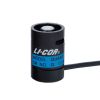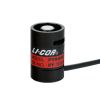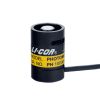LI-COR LI-191R Line PAR Sensors
Features
- Spatially averages PPFD over its 1m length
- Uses a 1m quartz rod under a diffuser to conduct light to a single Quantum sensor
- Improved water resistance for long-term outdoor deployment
- Free ground shipping
- Expedited repair and warranty service
- Lifetime technical support
- More
Overview
The LI-191R Line Quantum Sensor measures Photosynthetically Active Radiation (PAR) integrated over its 1-meter length. It is used to measure sunlight under a plant canopy, where the light field is non-uniform. It measures light in units of Photosynthetic Photon Flux Density (PPFD), which is expressed as μmol s-1 m-2.
Mechanics
The entire LI‑191R diffuser is sensitive to light over its 1-meter length. Since the diffuser is one continuous piece, the LI‑191R essentially integrates an infinite number of points over its surface into a single value that represents light from the entire 1-meter length. The diffuser and single photodiode in the LI‑191R provide stable, integrated measurements that are superior to averages provided by many linear sensors. Optical filters block radiation with wavelengths beyond 700 nm, which is critical for under-canopy measurements, where the ratio of infrared to visible light may be high.
- Absolute Calibration: ± 10% traceable to National Institute of Science and Technology (NIST). The LI-191 is calibrated via transfer calibration
- Sensitivity: Typically 7 μA per 1,000 μmol s-1 m-2
- Linearity: Maximum deviation of 1% up to 10,000 μmol s-1 m-2
- Response Time: 10 μs
- Temperature Dependence: ± 0.15% per °C maximum
- Cosine Correction: Acrylic diffuser
- Azimuth: < ± 2% error over 360° at 45° elevation
- Sensitivity Variation over Length: ± 7% maximum using a 2.54 cm (1”) wide beam from an incandescent light source.
- Sensing Area: 1 m × 12.7 mm (39.4” × 0.50”)
- Detector: High stability silicon photovoltaic detector (blue enhanced)
- Sensor Housing: Weatherproof anodized aluminum housing with acrylic diffuser and stainless steel hardware.
- Size: 121.3 L × 2.54 W × 2.54 cm D (47.7” × 1.0” × 1.0”)
- Weight: 1.4 kg (3.0 lbs.)
- Cable Length: 2 m, 5 m (6.5', 16.4')
- (1) LI-191R Line PAR Sensor
- (1) Bubble level
- (1) Detachable 10 ft. cable
- (1) Hard-sided carrying case
In The News
Supplying Seattle’s Drinking Water: Using Data Buoys to Monitor the Cedar River Municipal Watershed
Providing clean, safe, and reliable drinking water for the 1.6 million people in the greater Seattle area is a top priority for Seattle Public Utilities (SPU). With limited water supplies, SPU dedicates considerable resources to maintain its watersheds and mountain reservoirs. About 70 percent of Seattle Water comes from the Cedar River Municipal Watershed , and the other 30 percent comes from the South Fork Tolt River Watershed . [caption id="attachment_39574" align="alignnone" width="940"] Data buoy in Chester Morse Lake . (Credit: Kevin Johnson / Seattle Public Utilities) [/caption] Jamie Thompson, a fisheries biologist at SPU, monitors aquatic ecosystems centered on fish listed under the U.S. Endangered Species Act (ESA).
Read MoreData-Driven Advocacy on the Lower Deschutes River
Like many freshwater environments, the Deschutes River in Oregon is under pressure from development, pollution, and climate change. Many rivers, streams and lakes in the Deschutes Basin do not meet Oregon water quality standards –where state water quality monitoring assesses levels of bacteria, pH, dissolved oxygen, temperature, and fine sediment. Hannah Camel is the Water Quality Coordinator for the Deschutes River Alliance (DRA), a non-profit organization that focuses on the health of the lower 100 miles of the Deschutes River–the area most affected by human intervention. As a data-driven organization, the DRA has benefited from the installation of two NexSens X2 data loggers.
Read MoreExpanding the Port Everglades: Real-Time Monitoring of Water Quality Conditions from Planned Dredging Operation
The Port Everglades in Broward County, Florida, serves large trade vessels and cruiseliners and incoming and outgoing recreational boaters. However, as cargo ships become larger, the port must expand. A dredging project led by the US Army Corps of Engineers will substantially deepen and widen the port's navigation channel to accommodate larger Panamax cargo ships and modern cruise liners. As a result of this project, a large amount of sediment will be displaced into the water column. This suspended sediment may settle outside of the project area, burying benthic organisms like corals, and possibly carrying harmful particulates to other regions. [caption id="attachment_39497" align="aligncenter" width="2560"] A CB-950 and CB-25 deployed on site at Port Everglades.
Read More




















